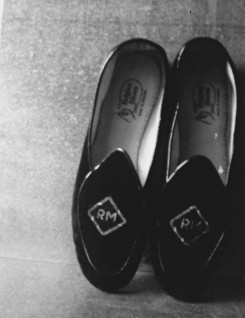When Patti Smith wakes up, her first concern is coffee. She doesn’t get up in the morning with thoughts of picking up her camera or notebook. According to her, coffee and her kids come first. Everything else — the art, poetry, and music — happens organically.

"Robert's Slippers" (2002) by Patti Smith. PHOTO COURTESY AGO
“Patti Smith: Camera Solo” at the Art Gallery of Ontario is the artist’s Canadian debut. While Smith is hailed as the godmother of punk, this exhibit explores her influences across various mediums. The 70 silver gelatin prints on display in the gallery give visitors the chance to see through the eyes of Smith and her camera.
Smith was at the ago last Wednesday for a special conversation with the gallery’s ceo and director, Matthew Teitelbaum. During the hour that she spoke, Smith managed to talk about everything from finding early influences in her mother’s Vogue magazines, to the parallels (not connections) between her work and that of Robert Mapplethorpe, a former partner and longtime friend.
The camera Smith used in her early photography was a vintage Land 250, and she continues to use the Polaroid to this day. When asked about whether or not the blur that exists in some of her photos was intentional, Smith was quick to dismiss this description of her work. Instead, she prefers to use the term “atmospheric” when describing the aesthetic of her photographs.
For Smith, the Land 250 is a simple camera that has its own limitations in terms of what it can and cannot capture. For example, she has yet to photograph the necklace that Mapplethorpe gave her as a gift in 1967 due to the camera’s inability to catch the necklace’s fine details. At other times, however, the “atmospheric” quality of her photos is a result of the environment in which the photograph was taken. One of the photos in the ago exhibit features a photo of a Hiroshima building engulfed in fog. Smith explained that she thought the fog was a result of a dirty camera lens, but even after rigorous wiping, the haze remained.
If Smith wanted to take a perfectly clear photograph, she could easily trade in her Polaroid for a high tech dslr camera, or even an iPhone. Yet it is evident from the collection of works on display at the ago that perfection is not what Smith is after; she is instead concerned with capturing the raw, flawed aspects of everyday life.
Death manifests itself as a common theme among the photographs in the exhibit; there are images of Walt Whitman’s tomb, a stone from the River Ouse (in which Virginia Woolf drowned herself in 1941), and Susan Sontag’s grave. These photographs demonstrate what Smith has deemed as her “strong relationship with the dead.” Although trying to capture the notion of death might seem like a slightly morbid fascination, to Smith, it is the most appropriate way to honour her heroes.
Smith is a careful and deliberate photographer. While she does like to photograph different aspects of everyday life, she is not constantly pressing the shutter button of her camera. Most objects she will dismiss as merely “stuff” — only things that are significant to her eventually become the subjects of her photography. A pair of slippers with the initials “R.M.” for Robert Mapplethorpe embroidered on the toes. Arthur Rimbaud’s utensils. A chipped coffee cup that once belonged to her father. These items are a few of the many things that make an appearance in Smith’s photographs, for they are objects that she treasures.
There is yet another simple philosophy behind Smith’s photography: she will only take photos of the objects that, in some way, capture the essence of their owner. While she was on tour with Neil Young, for instance, she managed to take a picture of his guitar, an item that Smith likens to a “holy relic.”
Yet another reason to be choosy with her subjects is the unfortunate fact that Polaroid ceased production of its instant film in 2008. Even if Smith wanted to continue using her camera forever, she could not. For the present, she must rely on her dwindling supply of expired Polaroid film.
The works featured in Camera Solo are a telling reflection of Smith’s honest and simple approach to taking photos. As she boldly declared during her talk at the ago, “I’m not trying to make a statement. I’m just trying to do my work.”
“Patti Smith: Camera Solo” runs at the ago until May 19, 2013.

